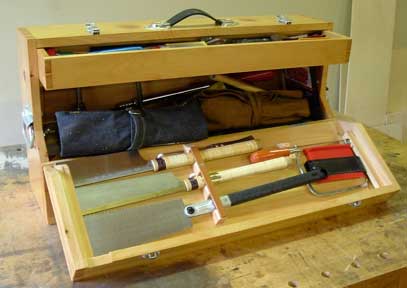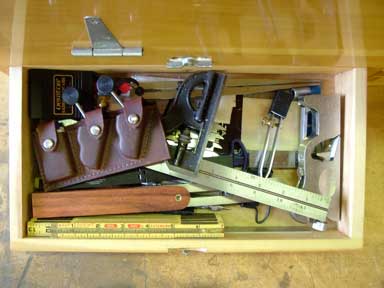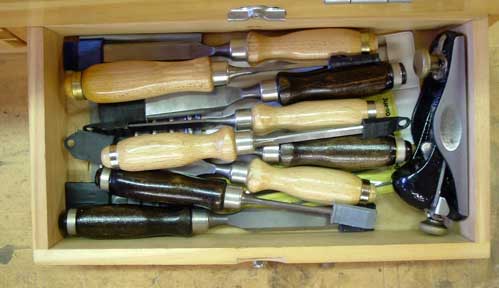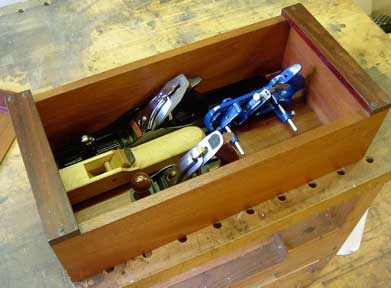Job Box Tool List, Part II
By Chris Black
In
Part I
of this series, I listed and discussed the hand tools I keep in my
carpentry toolbox. In this article, I'll go over the tools I stow in
my cabinetry and cabinet installation box and the different planes in
my handplane box. You'll notice quite a bit of overlap between the
carpentry box content and that of the cabinetry box. I consider it a
luxury to own more than one of any tool. But, once you get used to not
swapping tools from one box to another, the luxury quickly becomes a
necessity. Other advantages to having multiple tools are that you
don't leave tools behind if you forget to switch them from box to box,
and if a tool goes down, you always have a backup.
|

|
|
I take these basic hand tools with me if I'll be working in someone
else's shop, or if I'm on site installing cabinets I've built in my own
shop. Since you can't always complete the job in the shop, it goes
without saying that some assembly or fitting will need to done on the
job.
|
|
|
IN THE DOOR
-
Ryoba
- a two-sided Japanese saw capable of ripping and cross cutting.
-
Dozuki
- a Japanese backsaw. Sometimes I bring a small homemade miter box that fits this saw.
-
Small Dozuki
-
Japanese keyhole saw
- this saw is actually small enough to make a keyhole.
-
Coping saw
-
Contour gauge
- transfers a negative image of an item that needs to be matched.
|
|
INTERIOR TOP DRAWER
-
24" straight edge
-
24" flexible rule
- for measuring along spiral staircases, columns, etc.
-
Ink line
- a modern version of a Japanese sumitsubo. Similar to a western chalk line, but capable of producing a much finer line.
-
Standard chalk box
- replace the standard line with which it came with very thin mason's line for a crisper mark.
-
End nippers
- cuts nails off close to the surface.
-
Marking and Mortise gauge
- modify the pins with a file to a knife-edge instead of a point so it will slice rather than scratch the wood.
-
Yankee push drill
- guard this tool closely as it has a tendency to wander off.
-
Compass
-
Nail sets of various diameters
-
Razor knife
-
Small nail puller
-
Small pry bar
-
Blind nailer
- this clever device lifts a
sliver of wood off the surface so you can sneak a nail under it and
glue it down later. A very sharp flat carving gouge will also work.
Use medium CA glue and activator to glue down the sliver after the nail
is set.
-
Pencils
-
Draftsman's flexible curve
-
Brad driver
- pushes in small nails without smashing your fingers.
-
Yet another 3-prong adaptor
-
Multi-tipped screwdriver
-
Putty knife
- I've still never used one. I keep it around to lend out.
-
Scribe
- fits trim to irregular walls.
-
Plumb bob
-
Various grits of diamond hones
- these credit card size diamond stones are perfect for touching up anything that needs it when you're on the job.
|
|
|

|
LEFT DRAWER
-
Set of bench chisels
- 1/8", 1/4
"
, 3/8
"
, 1/2
"
, 5/8
"
, 3/4
"
and 1
"
-
Low angle block plane
-
Small router
- Stanley's 271 is no longer
in production but Lie-Nielsen makes an excellent version. Routers make
shallow mortises for strike hardware, hinges and cover plates.
-
Hari Kanna
- a Japanese drawshave. Works like a western drawknife and is the right answer for cleaning up dried glue in corners.
-
Needle rasp set
|

|
|
|
|
|
THE PLANE BOX
What goes in the plane box depends entirely on the job that day. The
box itself is based loosely on Toshio Odate's toolbox that appears in
his book, Japanese Woodworking Tools (290426). Yours should be long
enough to accommodate your longest plane and wide enough to store
several planes side by side. When determining the height, take into
consideration things like aprons, hearing protection, glue bottles and
anything else you might want when you're away from the shop. Here's a
list of planes I use most often that either don't already live in my
other boxes or ones I think I'll need on that day.
|

|
-
Jointer plane
- the right tool for fitting entry doors and swollen cabinet components.
-
Jack plane
- usually a #5 because it fits
in the box. With a cambered or curved blade, the jack plane quickly
flattens crowned floor joists or textures beams.
-
Fillister plane
- also called a fenced rabbet or rebate plane. Makes shiplaps in siding and steps in door thresholds.
-
Smoothing plane
- usually a #3 or #4. If
I'll be working in dense tropical hardwoods sometimes I'll bring my
HNT
Gordon smoothing plane
, which is bedded at 60 degrees.
-
#80 scraper plane
- card scrapers get too hot to handle during heavy use.
I have other planes, but use them infrequently. They are antique
hollows and rounds for reproducing moldings, compass planes for chair
seats and various homemade jobs for odd bits of one off work.
|